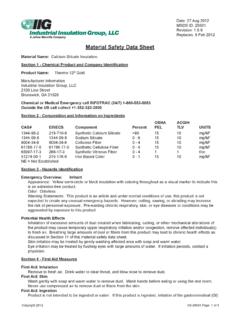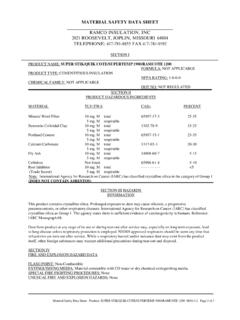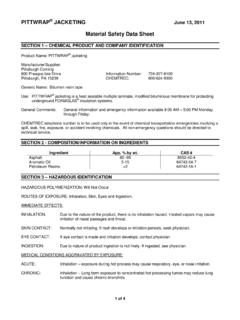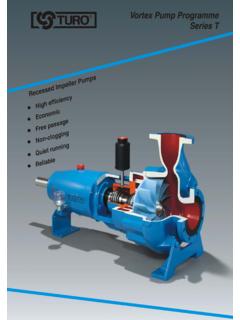Transcription of Section 1 - Product and Company Identification
1 Material Name: Fiber Glass Wool Commercial & Industrial Insulation Safety Data Sheet ID: 1009 _____ Page 1 of 7 Issue Date: 09/08/2011 Revision: Section 1 - Product and Company Identification Hazard Label WARNING label Company Information Johns Manville Telephone: 303-978-2000 8:00AM-5:00PM M-F Insulation Systems Internet Address: Box 5108 Emergency: 800-424-9300 (Chemtrec, In English) Denver, CO 80127 USA Trade Names: 1000 Series Spin Glas Board; 13/16" Micro-Aire Duct Board; 800 Series Spin-Glas Board Insulations; Blended Blowing Wool; Fabrication Board; Grooved Duct Board; Hullboard (Incombustible); Hullinsul Fiber Glass Board; Incombustible Microlite ; Insul-SHIELD Coated Black; Linacoustic RC; Mat-Faced Micro-Aire Duct Board; Micro-Flex Large Diameter Pipe and Tank Wrap; Micro-Lok HP; Micro-Lok Pipe Insulation; Micromat Rx ; Permacote Linacoustic (Types: Standard, HP, and R-300); Precipitator Spin Glas ; R series Microlite (plain, FSK, PSK, & vinyl faced); Spin Glas HTB 26 Spiracoustic Plus ; SuperDuct Boards; SuperDuct RC Boards Section 2 - Hazards Identification Emergency Overview Inhalation of excessive amounts of dust from the Product may cause temporary upper respiratory irritation and/or congestion--remove individual to fresh air.
2 In high temperature applications, treatment, curing, or in geographic areas of high heat and humidity, this Product may release gases irritating to the eyes, nose and throat. Inhalation Temporary mechanical irritation may occur upon exposure to dust or fibers released from cutting this Product . Irritation of the upper respiratory tract, coughing, and congestion may occur in extreme exposures. Severe irritation of the mouth, nose, and throat, as well as signs of central nervous system depression (drowsiness, dizziness, headache), may occur upon inhalation of vapors or gases. Skin Temporary irritation (itching) or redness may occur. Ingestion This Product is not intended to be ingested (eaten). If ingested, it may cause temporary irritation to the gastrointestinal (digestive) tract.
3 Eyes Temporary irritation (itching) or redness may occur. Ears Temporary irritation (itching) or redness may occur. Primary Routes of Entry (Exposure) Eyes, skin, inhalation (breathing dust and fibers) and ingestion. Target Organs Nose (nasal passages), throat, lungs, skin, eyes Medical Conditions Aggravated by Exposure Pre-existing chronic respiratory, skin, or eye diseases or conditions. Section 3 - Composition/Information on Ingredients CAS # Component Percent Not Applicable Continuous Filament Glass Fiber 1-10** Not Applicable Fiber Glass Wool 50-98 Material Name: Fiber Glass Wool Commercial & Industrial Insulation Safety Data Sheet ID: 1009 _____ Page 2 of 7 Issue Date: 09/08/2011 Revision: Not Available Non-woven, AP, FSK, PSK, or vinyl facings.
4 Or vinyl, acrylic, or latex coatings 0-40 Not Available Urea extended phenol-formaldehyde binder (cured) 2-18* Not Available Urea extended phenol-melamine formaldehyde binder (cured) 2-18* Not Available Acrylic Coating (present in SuperDuct RC only) 0-10 25038-59-9 Polyester fiber (present in black products only) 1-10 50-00-0 Formaldehyde <1 1333-86-4 Carbon black, bound (present in black products only) <1 1309-64-4 Antimony trioxide Component Information * Binder may be either of these. ** Component of scrim facings Antimony trioxide (fire retardant) may be present in the facings and/or adhesives. Occupational exposure to airborne antimony trioxide is not expected to occur due to Product form(s) and intended use(s). Exposure limit is given for reference only.
5 Formaldehyde may be released by partial hydrolysis of the urea formaldehyde polymer. General Product Description Gold, yellow, or black fibrous glass blanket, board, or formed shapes, with or without facings. Section 4 - First Aid Measures First Aid: Inhalation If dust is inhaled in excess of exposure limits referenced in Section 8 of this safety data sheet, remove individual to fresh air. Drink water to clear throat, and blow nose to remove dust. A saline spray in the nose may help clear any fibers. First Aid: Skin Wash gently with soap and water to remove dust and fibers. Alternatively, fibers can be removed from the skin by use of ordinary masking or wrapping tape. Should irritation persist, seek medical attention. First Aid: Ingestion Rinse mouth with water to remove dust and fibers and drink plenty of water to help reduce irritation.
6 If irritation persists, seek medical attention. First Aid: Eyes Do not rub or scratch eyes. Dust particles may cause the eye to be scratched. Flush eyes with large amounts of water until irritation subsides. If irritation persists, seek medical attention. First Aid: Ears Wash exposed skin with soap and water. If irritation develops in the inner ear, seek medical attention. First Aid: Notes to Physician Dust from the Product may cause mechanical irritation of the eyes, skin, and upper respiratory tract. Treat symptomatically. Irritating gases may be released under conditions of high heat or humidity. At high levels, these could cause severe upper respiratory and eye irritation. Formaldehyde gas is a skin and respiratory sensitizer. Treatment should be directed toward removing the source of irritation with symptomatic treatment as necessary.
7 Section 5 - Fire Fighting Measures Flash Point: Not applicable Method Used: Not applicable Upper Flammable Limit (UFL): Not applicable Lower Flammable Limit (LFL): Not applicable Auto Ignition: Not determined Flammability Classification: Not determined Rate of Burning: Not determined General Fire Hazards There is no potential for spontaneous fire or explosion. Inorganic glass fibers are naturally non-combustible and non-flammable. Extinguishing Media Carbon dioxide (CO2), water, water fog, dry chemical. Fire Fighting Equipment/Instructions No special procedures are expected to be necessary for this Product . Normal fire fighting procedures should be followed to avoid inhalation of smoke and gases. Material Name: Fiber Glass Wool Commercial & Industrial Insulation Safety Data Sheet ID: 1009 _____ Page 3 of 7 Issue Date: 09/08/2011 Revision: Section 6 - Accidental Release Measures Clean-Up Procedures Pick up large pieces.
8 Vacuum dusts. If sweeping is necessary, use a dust suppressant such as water. Do not dry sweep dust accumulation. These procedures will help to minimize potential exposures. Section 7 - Handling and Storage Handling Procedures Use protective equipment as described in Section 8 of this safety data sheet when handling uncontained material. Handle in accordance with good industrial hygiene and safety practices. Storage Procedures Warehouse storage should be in accordance with package directions, if any. Material should be kept clean, dry, and in original packaging. Section 8 - Exposure Controls / Personal Protection Exposure Guidelines A: General Product Information The Occupational Safety and Health Administration (OSHA) has not adopted specific occupational exposure standards for fiber glass.
9 Fiber glass is treated as a nuisance dust and is regulated by OSHA as a particulate not otherwise regulated (total dust) shown in CFR Table Z-3. Respirable fraction 5 mg/m3 Total dust 15 mg/m3 JM has adopted the fiber glass industry voluntary Product Stewardship Program (PSP), formerly the NAIMA-OSHA Health and Safety Partnership Program (HSPP). Under the PSP, JM recommends that exposures be limited to the voluntary concentration of 1 f/cc TWA for fibers longer than 5 microns with a diameter less than 3 microns. This will help minimize potential irritation effects. The PSP also includes the PPE recommendations described below. B: Component Exposure Limits Formaldehyde (50-00-0) OSHA: ppm TWA ppm Action Level; ppm TWA; 2 ppm STEL (Irritant and potential cancer hazard - see 29 CFR ) 3 ppm TWA (unless specified in ) ACGIH: ppm Ceiling Carbon black, bound (present in black products only) (1333-86-4) OSHA: mg/m3 TWA mg/m3 TWA ACGIH: mg/m3 TWA PERSONAL PROTECTIVE EQUIPMENT Personal Protective Equipment: Eyes/Face Safety glasses with side shields are recommended to keep dust out of the eyes.
10 Personal Protective Equipment: Ears Use ear protection (earplugs, hood, or earmuffs) to prevent airborne dust or fibers from entering the ear, if necessary. Personal Protective Equipment: Skin Leather or cotton gloves should be worn to protect against mechanical abrasion. See also Personal Protective Equipment: General, below. Personal Protective Equipment: Respiratory A NIOSH-approved respirator should be used if ventilation is unavailable, or is inadequate for keeping levels below the applicable exposure limits referenced in Section 8 of this SDS. Ventilation In fixed manufacturing settings, local exhaust ventilation should be provided at areas of cutting, milling or other processing to remove airborne dust and fibers. Material Name: Fiber Glass Wool Commercial & Industrial Insulation Safety Data Sheet ID: 1009 _____ Page 4 of 7 Issue Date: 09/08/2011 Revision: Personal Protective Equipment: General Wear a cap, a loose-fitting, long-sleeved shirt and long pants to protect skin from irritation.

















